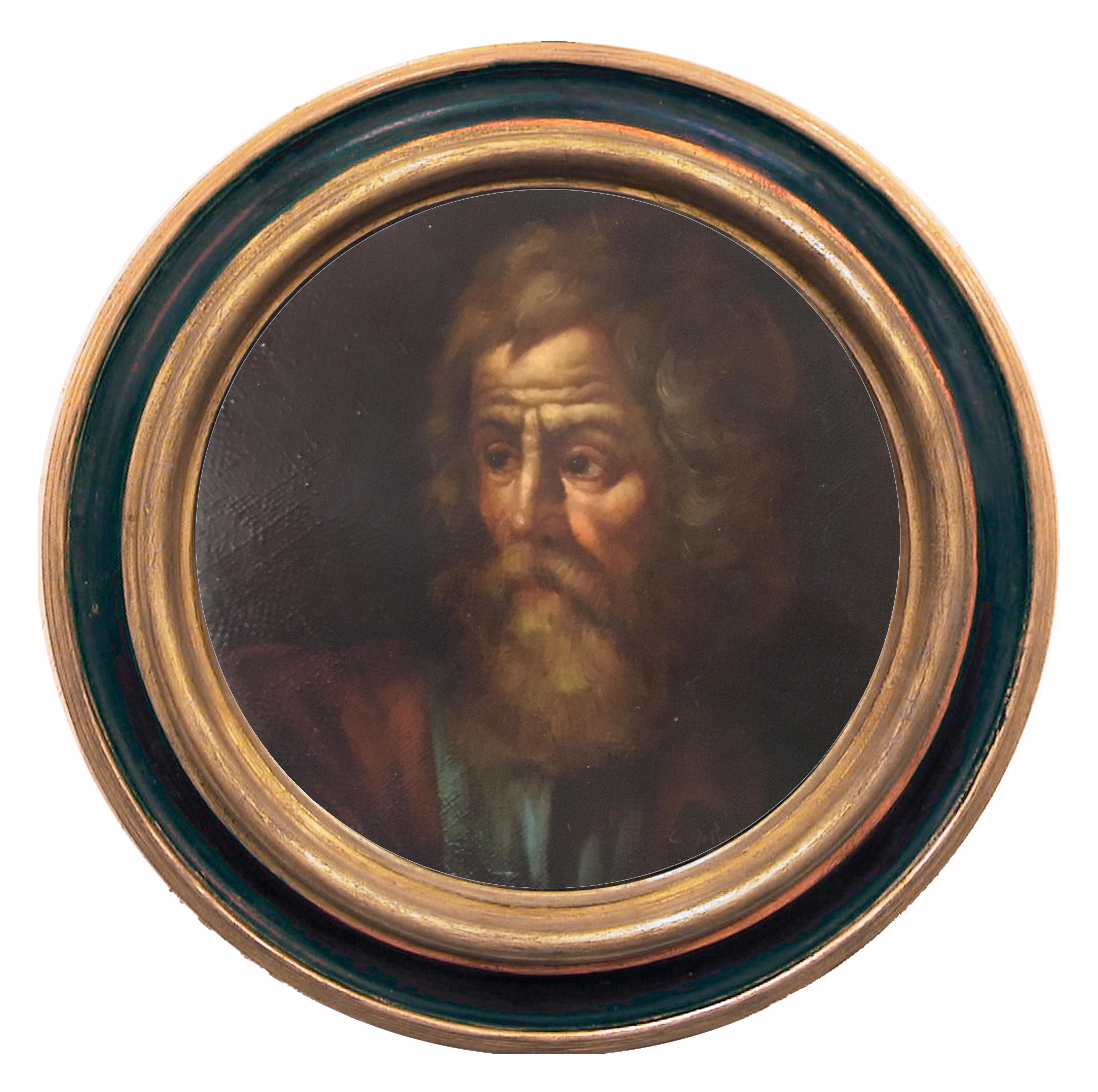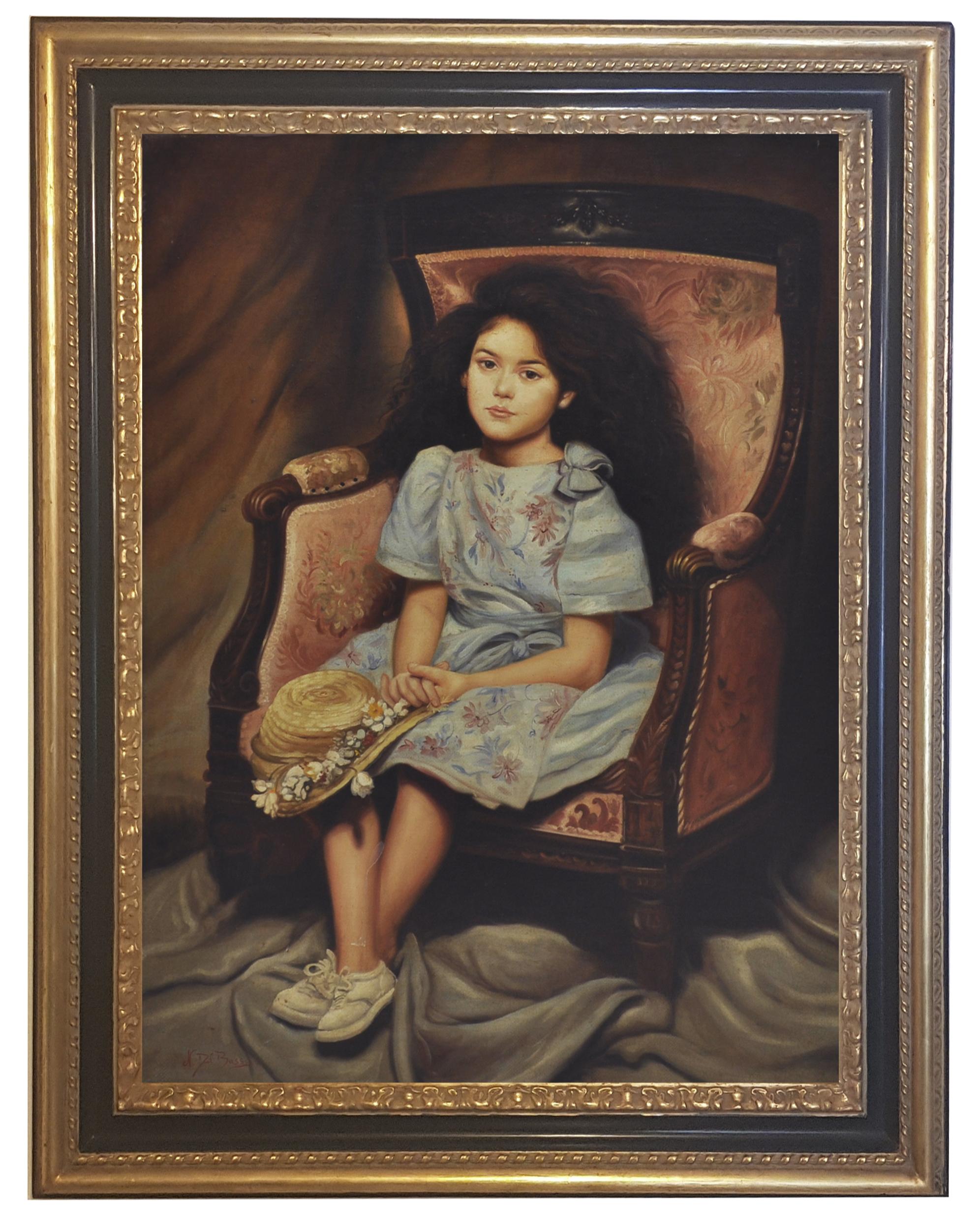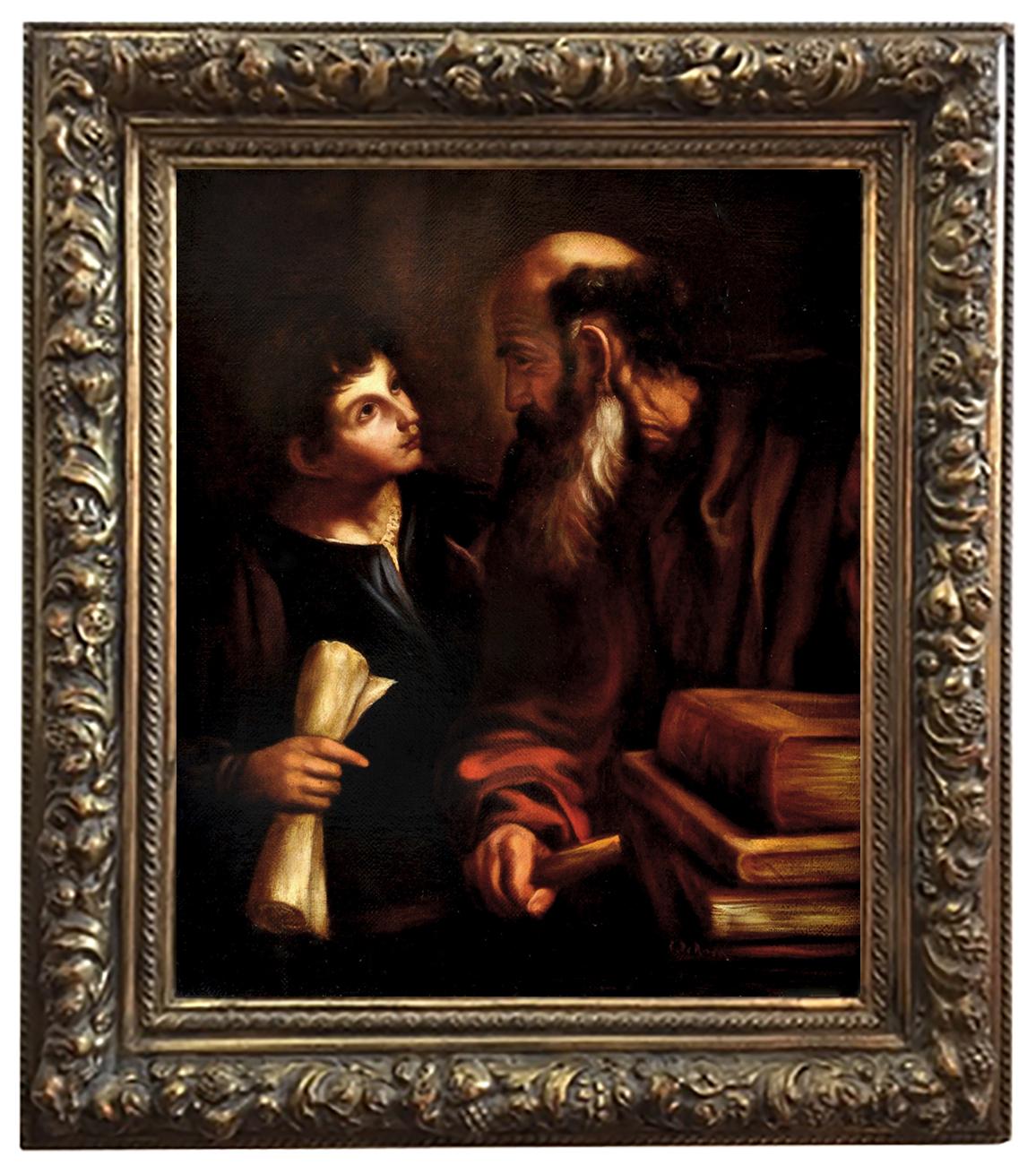Items Similar to St John the Baptist as a Child, Early 19th Century Italian School, Oil Painting
Want more images or videos?
Request additional images or videos from the seller
1 of 6
19th century Italian SchoolSt John the Baptist as a Child, Early 19th Century Italian School, Oil Painting
About the Item
Oil on canvas
Image size: 15 x 19 inches (38 x 48.25 cm)
Handmade gilt pierced frame
This is a beautiful early 19th Century Italian Old Master oil painting with the subject matter of Saint John the Baptist as a very young child. The tender detail in the face and the palette of soft warm tones makes this a staggeringly beautiful oil painting.
This piece presents Saint John the Baptist in his traditional childhood setting: the desert. John wears a hair shirt, symbolising his ascetic life in the wilderness. As Saint Luke described it (Luke I, 80) 'And the child grew, and waxed strong in spirit, and was in the deserts till the day of his shewing unto Israel'. This explains that his only clothing is an animal hide. He looks at the observer with a charming smile, as if sharing his love of the lamb that symbolises Jesus Christ.
The text that appears on the fabric seems to read 'Ecce Agnus Dei' (behold the lamb of God). This phrase was uttered by St. John the Baptist upon seeing Jesus for the first time as noted in John 1:29.
- Creator:19th century Italian School (Italian)
- Dimensions:Height: 19 in (48.26 cm)Width: 15 in (38.1 cm)
- More Editions & Sizes:1 of 1Price: $7,008
- Medium:
- Movement & Style:
- Period:
- Condition:
- Gallery Location:London, GB
- Reference Number:1stDibs: LU52413220522
About the Seller
5.0
Vetted Seller
These experienced sellers undergo a comprehensive evaluation by our team of in-house experts.
Established in 2007
1stDibs seller since 2014
64 sales on 1stDibs
Typical response time: 4 hours
- ShippingRetrieving quote...Ships From: London, United Kingdom
- Return PolicyA return for this item may be initiated within 14 days of delivery.
More From This SellerView All
- Portrait of a GentlemanLocated in London, GBOil on canvas Image size: 17 x 23 1/2 inches (43 x 60 cm) Contemporary William Kent hand made frameCategory
18th Century Portrait Paintings
MaterialsCanvas, Oil
- Portrait of Herbert Fisher, Mid-19th Century Oil Painting, Original Watts FrameBy George Frederic WattsLocated in London, GBOil on canvas c.1855 - 1860 Image size: 19 x 14 inches (48.25 x 37.25 cm) Original Watts frame The Sitter Herbert William Fisher (1826 - 1903) was a British historian, best known for his 'Considerations on the Origin of the American War' (1865). Fisher was tutor to the future King Edward VII, and served as Private Secretary to the 5th Duke of Newcastle. in 1863 he became Private Secretary to the Prince of Wales, his former pupil, before being appointed to the position of Vice-Warden of the Stannaries in 1870. One of his daughters, Adeline, married Ralph Vaughan Williams. George Frederick Watts Watts (1817 - 1904) was a British painter and sculptor associated with the Symbolist movement. He is known to have said 'I paint ideas, not things'. Watts became famous in his lifetime for his allegorical works, such as 'Hope' and 'Love and Life' in which the emotions and aspiration life were intended to be represented in a universal symbolic language. Watts was born in Marylebone in central London on the birthday of George Frederic Handel (after whom he was named), to the second wife of a poor piano-maker. He showed artistic promise very early, learning sculpture from the age of 10 with William Behnes, starting to study devotedly the Elgin Marbles (later writing "It was from them alone that I learned") and then enrolling as a student at the Royal Academy Schools at the age of 18. He first exhibited at the Academy in 1837, with a picture of "The Wounded Heron" and two portraits, but his attendance at the Academy was short-lived, and his further art education was confined to personal experiment and endeavour, guided by a constant appeal to the standard of ancient Greek sculpture. He also began his portraiture career, receiving patronage from his close contemporary Alexander Constantine Ionides, who later came to be a close friend. In 1849 the first two of the allegorical compositions which form the most characteristic of the artist's productions were exhibited—"Life's Illusions," an elaborate presentment of the vanity of human desires, and "The people that sat in darkness," turning eagerly towards the growing dawn. In 1850 he first gave public expression to his intense longing to improve the condition of humanity in the picture of "The Good Samaritan" bending over the wounded traveller; this, as recorded in the catalogue of the Royal Academy, was "painted as an expression of the artist's admiration and respect for the noble philanthropy of Thomas Wright, of Manchester," and to that city he presented the work. From the late 1840s onward he painted many portraits in France and England, some of which are described below. Notable pictures of the same period are “Sir Galahad...Category
1850s Victorian Portrait Paintings
MaterialsCanvas, Oil
- Portrait of Thomas Cooper Gotch, 19th Century Oil PaintingLocated in London, GBOil on canvas on board Image size: 7 x 5¼ inches (18 x 13.5 cm) Framed This portrait of Thomas Gotch is by his lifelong friend and confidante, Jane Ross, whom he met at Heatherley’s...Category
1880s English School Portrait Paintings
MaterialsCanvas, Oil
- Portrait of a Lady, 17th Century Flemish Oil Old MastersBy Jacob HuysmansLocated in London, GBJacob Huysmans Flemish 1633 - 1696 Portrait of a Lady Oil on canvas Image size: 49 x 40 ¼ inches Gilt frame Huysmans was born in Antwerp and came to England during the reign of Charles II where he became one of the fashionable painters of the court.. The diarist Samual Pepys noted the artist as capable of a more exact likeness than Lely. Certainly the diarist records that by August 1664 in the circle of Queen Catherine...Category
17th Century Old Masters Portrait Paintings
MaterialsCanvas, Oil, Acrylic
- Portrait of Conrad Friedrich Hurlebusch, Early 18th Century Oil PaintingBy Dominicus van der SmissenLocated in London, GBDominicus van der Smissen Early 18th Century Portrait of Conrad Friedrich Hurlebusch Oil on canvas Image size: 20½ x 16¼ inches Period gilt frame This is a portrait of Conrad Friedrich Hurlebusch, composer, Kapellmeister and organist, whom Van der Smissen most probably portrayed during his stay in Hamburg, Brunswick or Amsterdam. The identification is based on the reproduction of the portrait which was engraved by Pieter Anthony Wakkerdak (1740- 1774). Van der Smissen has reduced the face of the sitters to an egg-shaped oval in three-quarter view, applying diminution to one half of the figure’s torso, which is farther away from the viewer. This partial side view, with the head turned to look at the viewer over the shoulder, creates spatial depth and brings the figure to life by avoiding the stiffness of a frontal depiction. Because the artist chose to highlight the figure from above, a distinct shadow is cast under the tip of the nose, in the shape of a triangle. This is an often recurring and almost ‘signature’-like feature in Van der Smissen’s oeuvre. Hurlebusch's garments are of a very high quality and serve to reflect the sitter’s wealth, status and elegance. During this period, gentlemen often shaved their heads in order to facilitate the wearing of a wig, which wouldbe worn with a suit. Here Hurlebusch has been depicted in a luxurious turban-like cap lined with lynx fur, a highly fashionable and expensive material at the time. Over his shirt, he wears a velvet fur-lined gown adorned with decorative clasps fashioned from silver braid. The elegant informality of his appearance can be seen in his unbuttoned shirt and the unfastened black ribbon hanging from his button hole, which has been artfully arranged into a fluttering drape by the portraitist. The Sitter Hurlebusch was born in Brunswick, Germany. He received the first instructions in his field from his father Heinrich Lorenz Hurlebusch, who was also a musician. As an organ virtuoso, he toured Europe, visiting Vienna, Munich and Italy. From 1723 to 1725 he was Kapellmeister in Stockholm; later he became Kapellmeister in Bayreuth and Brunswick, and lived in Hamburg from 1727 to 1742, where he had contact with fellow composers Johann Mattheson and Georg Philipp Telemann. He made his living composing, performing and teaching. In 1735 and 1736, he is believed to have visited Johann Sebastian Bach in Leipzig, who promoted Hurlebusch’s compositions as the local seller...Category
Early 18th Century Old Masters Portrait Paintings
MaterialsCanvas, Oil
- Portrait of William Ewart GladstoneLocated in London, GBOil on canvas Image size: 10 x 30 1/4 inches (25.5 x 77 cm) Original gilt Watts frame This is a head and shoulders portrait of William Ewart Gladstone painted after a photograph tak...Category
19th Century Naturalistic Portrait Paintings
MaterialsCanvas, Oil
You May Also Like
- Men portraitBy Giovanni Maria delle Piane dit Mulinaretto (Genoa 1670 - Monticelli d´Ongina 1745)Located in BELEYMAS, FRGiovanni Maria DELLE PIANE, known as IL MULINARETTO (Genoa, 1660 – Monticelli d'Ongina, 1745) Portrait of a man Oil on oval canvas H. 108 cm; L. 83 cm Provenance: Nino Ferrari Colle...Category
1730s Italian School Figurative Paintings
MaterialsCanvas, Oil
- COUNTRY GIRL- Angelo Granati Neapolitan School - Italy - Oil on canvas painting.By Angelo GranatiLocated in Napoli, ITCountry girl - Angelo Granati Italia 2005 - Oil on canvas cm. 51 x 38 In this precious painting, the painter drew inspiration from the masterpieces of the Neapolitan...Category
Early 2000s Italian School Portrait Paintings
MaterialsOil, Canvas
- PHILOSOPHER - Spanish School - Italian Figurative Oil on Canvas PaintingBy Ciro De RosaLocated in Napoli, ITPHILOSOPHER - Oil on canvas diam. cm.26 by Ciro De Rosa, Italy,2011 Gold leaf gilded wooden frame available on request The beautiful Flemish-style oil on canvas painting by the paint...Category
21st Century and Contemporary Italian School Portrait Paintings
MaterialsOil, Canvas
- CHILD ON ARMCHAIR - Italian School - Oil on Canvas Italian Figurative PaintingBy Nicola Del BassoLocated in Napoli, ITChild on the armchair - Nicola Del Basso Italia 2003 - Oil on canvas cm.100x80 Here we admire the portrait of a little girl sitting on a pink velvet armchair. Dry, simple design and ...Category
Early 2000s Italian School Portrait Paintings
MaterialsOil, Canvas
- YOUTH AND WISDOM- In the Manner of Caravaggio Figurative Oil on Canvas PaintingBy Ciro De RosaLocated in Napoli, ITYouth and wisdom -Ciro De Rosa Italia 2007 - Oil on canvas cm.60x50 The painting by Ciro De Rosa is a beautiful reinterpretation of the famous biblical painting "The Sacrifice of Isaac...Category
Early 2000s Italian School Portrait Paintings
MaterialsCanvas, Oil
- AUTUMN'S ALLEGORY - Eugenio De Blasi - Italian Portrait Italian Oil on CanvasBy Eugenio De BlasiLocated in Napoli, ITAutumn's Allegory - Oil on canvas cm.60x50, Italia, 2007, Eugenio De Blasi (3c59a) The painting by Eugenio De Blasi is an autumn allegory inspired by the allegorical figures of the ...Category
Early 2000s Italian School Portrait Paintings
MaterialsCanvas, Oil
Recently Viewed
View AllMore Ways To Browse
Art As Antique
15 Century
Art Of The 19th Century
Italy Antique
19th Century Italian Art
Antique Italian Painting Paintings
15 Century Earlier
Italian Old Masters
Italian Old Master
Antique Italian Oil Painting
Antique Oil Painting Italy
Antique Italian Old Masters
Italian 19th Century Painting
19th Century Italian Oil
19th Century Oil Painting Italy
Italian Gilted Antique Frame
Antique St Johns
19th Century Italian Oil On Canvas





